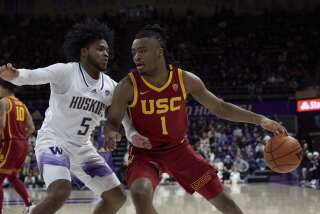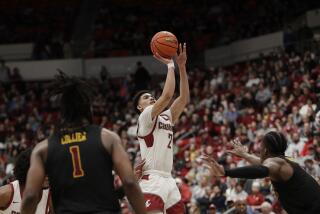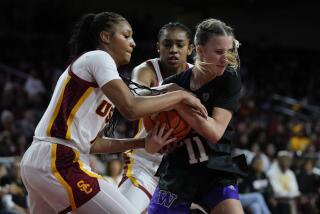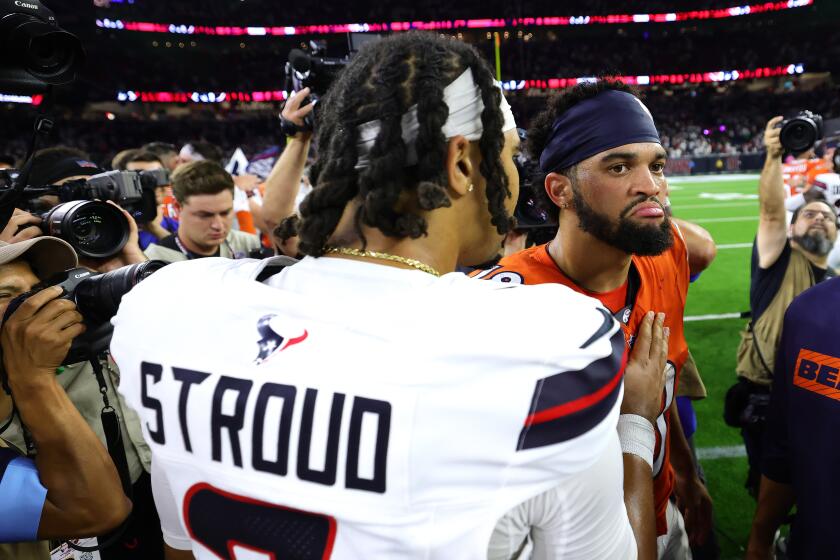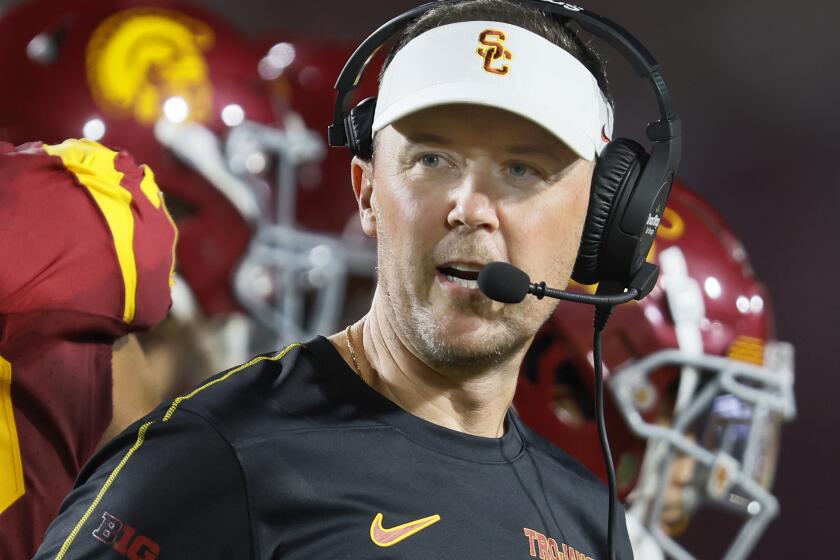In what areas is USC’s passing game struggling? All of them
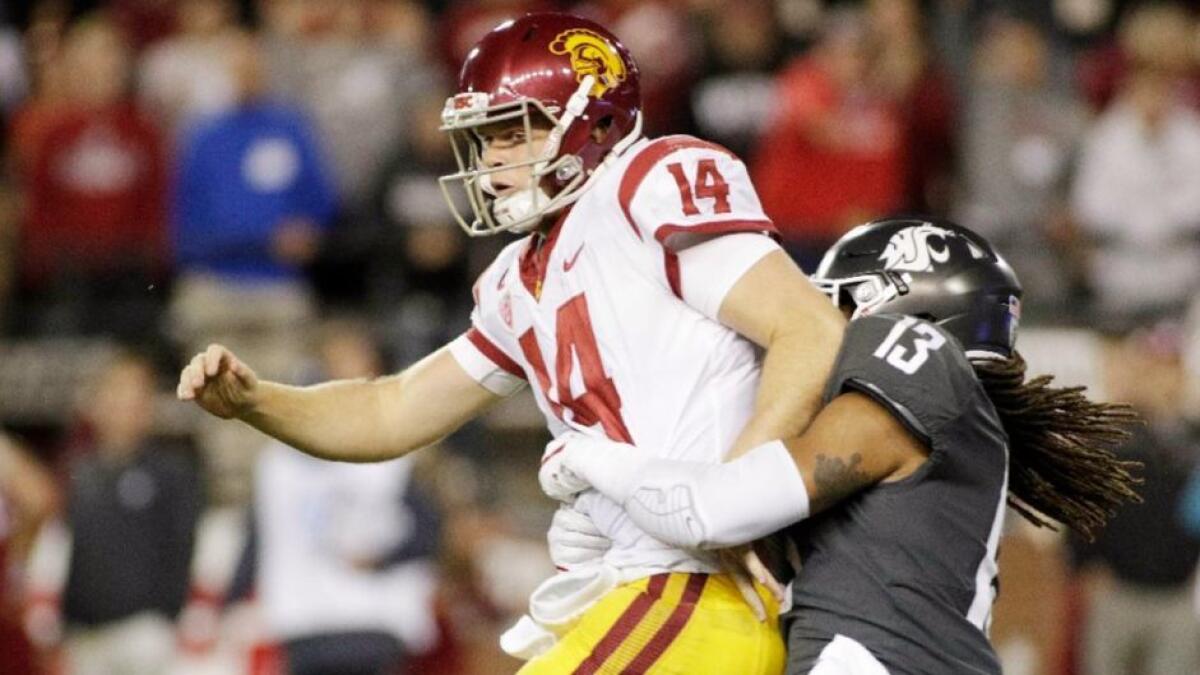
Tee Martin has no regrets about his game planning this season. He has regrets about USC’s inability to convert an interception at Washington State’s three-yard line into a touchdown. He has regrets about the result. But not about the calls.
“I mean, you call those same plays again,” said Martin, USC’s offensive coordinator. “You trust your guys.”
The sequence — two failed zone-read runs against a loaded box and a fade to a freshman, reception-less tight end — helped sink USC on Friday in its first loss this season. The three plays also showcased much of what has gone wrong for USC’s offense over the first five games: play calling, dwindling options in the passing game and defenses selling out to stop the run.
The problems are particularly difficult to address quickly because they are widespread, touching every part of the offense, and they have been exacerbated by a spate of injuries. The performance against Washington State displayed all of them.
A review of USC’s failed passes against the Cougars distributes blame equally among USC’s offensive line, receivers and quarterback.
Twenty one dropbacks ended in an incompletion, sack or a Sam Darnold scramble. Pressure contributed to seven of them. Imprecise throws contributed to eight. Receivers failing to get open contributed to another eight. There was also a dropped pass, miscommunication between Darnold and a receiver, and a flea-flicker gone wrong.
Defenses made adjustments to Darnold, who has thrown nine touchdowns with eight interceptions this season. Perhaps Washington State’s most effective wrinkle was clogging the middle of the field, where Darnold usually gouges the secondary. He completed three of only six passes over the middle for 40 yards.
“I’m expecting Oregon State to do the same thing,” Darnold said. “And I would if I was them as well.”
Darnold missed a few open receivers, but mainly he has been imperfect on throws into tight coverage.
“I haven’t really been as on target as I’d like to be when it comes to deep balls outside,” Darnold said. “And then our receivers would say that they haven’t made the plays that they should make.”
Teams have also limited Darnold’s creativity while extending plays. Other than on designed rollouts, Darnold didn’t complete a pass against Washington State while scrambling out of the pocket.
These guys are gonna be good. We’re gonna get there. But we’re still a work in progress. No question about that.
— Tee Martin, USC offensive coordinator
USC’s struggles at receiver and offensive line stem, in part, from a more obvious source: injuries. The Trojans were without three starting linemen for most of the game against Washington State. They were without two receivers. And the loss of tight end Daniel Imatorbhebhe to a hip flexor injury has proved much more costly than expected.
Without USC’s normal No. 2 option, Steven Mitchell Jr., defenses have bracketed Deontay Burnett. Often, he is double-teamed. Other times, a safety shades him or linebackers drop deeper to disrupt his routes.
“I can tell they’re keying in on me,” Burnett said. “That’s part of football. You just have to adjust to it. That leaves opportunity for other guys.”
But those other guys have been unable to make enough difficult catches.
“News flash: We lost a lot of really good players that have gone off to the NFL right now,” Martin said. “These guys are gonna be good. We’re gonna get there. But we’re still a work in progress. No question about that.”
USC has been forced to rely on inexperienced receivers who rarely played in the beginning of the season. Even Tyler Vaughns, who had an impressive training camp and led USC with six receptions for 89 yards Friday, had limited playing time early.
Martin said he would’ve liked to rotate the young receivers more in USC’s opening games if the Trojans could have.
“If we weren’t going into overtime against Texas,” Martin said. “I don’t know when you do it. I mean, Western Michigan was close. When do you do it? You don’t learn against Stanford at home in a close game. It’s not the time to experiment.”

The losses at receiver and offensive line have limited the play-calling options for the Trojans.
One option would’ve been to pound the ball on the ground. Young linemen, coach Clay Helton has said, usually pick up run blocking before pass blocking. But USC went to Ronald Jones II only 14 times, the lowest rate for USC’s starting tailback this season.
“I still feel good about the game plan,” Martin said. “I thought the run game plan was great. I thought the passing game plan was great. ... At the end of the day, we’ve gotta make the plays. We’ve gotta execute.”
Helton rarely shows much emotion, but he spoke with a rare edge after Tuesday’s practice.
“Are we better from last year to this year?” Helton said. “Yes. Do we need to improve from the month of September to the month of October? Yes.
“I know that Tee and that group will get it done. I have utter faith that they’re gonna get it done.”
Follow Zach Helfand on Twitter @zhelfand
More to Read
Go beyond the scoreboard
Get the latest on L.A.'s teams in the daily Sports Report newsletter.
You may occasionally receive promotional content from the Los Angeles Times.
